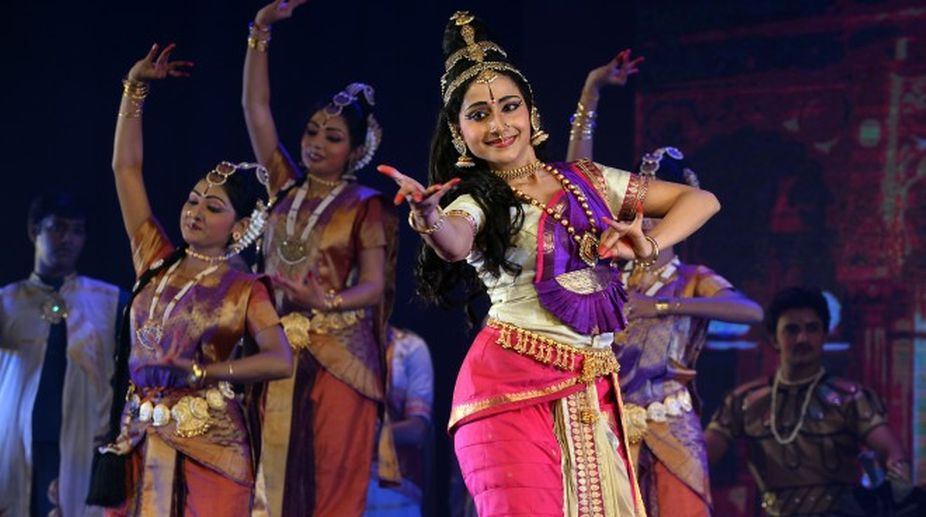Guinness World Record of ‘Classical Dance Relay Marathon’ in MP
Officials of the Guinness Records handed over the certificate of the world record to Madhya Pradesh Chief Minister Dr Mohan Yadav at the festival on Thursday evening.

(Photo: AFP)
The Sangeet Natak Akademi (SNA) organised Yoga Parva on the occasion of the International Yoga Day,featuring the diverse cultural expressions in the context of Yoga. The festival also presented some of India's performing and martial arts inspired by Yoga.
Opening with auspicious Vedic chants, the three-day festival showcased martial arts like Kalaripayattu from Kerala; Malla-Khamb and Silambattam from Karnataka; Gatka from Punjab; Mati Akhada from Majuli, Assam; and the acrobatic Bandha Nritya by the Goti Puas from Odisha.
Advertisement
There were Buddhist chanting, Dhrupad by Pt Brij Bhushan Goswami, Santoor and Flute recitals and a Violin duet in Carnatic music.
Advertisement
The classical dances included Odissi, Bharatanatyam, Sattriya and Chhau. The enriching lecture-demonstration Yoga of Indian Dance, by SNA awardee Mohiniyattam exponent Mandakini Trivedi, was impressive.The other speakers were Acharya Pratishtha and Nalini Asthana, who explained how our traditional and performing arts are connected with Yoga.
The inaugural day presented the auspicious Vedic chanting from Rigveda by Rishiraj Patha and disciples. This was followed by a Santoor recital by Abhay Rustam Sopori, who played Aalap-Jod and a couple of compositions in Raga Bheem, before Shagun Bhutani took the stage for Klishta-Aklishta, a solo Chhau dance presentation.
Shagun trained in Odissi, Chhau and contemporary dance; introduced it as her own perspective of Yoga that helped her realise the potential of her own body.
The dance opened with very slow Saraikela Chhau movements, on a melodious Aalap in raga Desh on Shehnai byVikas Babu and gathered tempo with the beats of the Dhol by Swapan Acharya, that gradually proceeded to faster tempo. The raga changed to Maru Bihag when Ramchandra Sahu started singing the Sanskrit Shlokas and the dancer wrapped and unwrapped multi-coloured cloth strips, interpreting the Sutra "Atha Yoga-Anushasanam", stretching the body in controlled movements of Yogic postures and Mudras that concluded with "Namaskar".
Shagun is a welltrained dancer but her KlishtaAklishta concept was rather Klishta (complicated) for the viewers. The evening concerts opened with the martial arts performers, before Odissi recital by SNA’s Bismillah Khan Yuva Puraskar awardee Rahul Acharya.
The taut-bodied male dancer, gifted with a pleasing stage presence and amazing agility, opened with Sthayee, etching the Odissi stances of Chauka and Tribhanga like a sculpture with the expansive sweep of arm movements, giving his Odissi a wide ambit and lyrical grace at the same time.
Rahul impressed with his command over rhythm as well. Suryashtakam was his other energetic presentation. The Sun God has been worshipped in India from time immemorial as a symbol of strength, vitality, health and immortal life. Rahul surcharged the atmosphere with his completely articulate, immensely graceful and blissfully energetic dance movements.
His impressive performance was enhanced with melodious live music provided by Guru Niranjan Patra on the Mardal, Sukanta Kumar Kundu (Vocal), Srinibas Satpathy on the Flute and Prafulla Mangaral on the Manjira. Mallika Kandali, the leading Sattriya dancer and author from Guwahati, opened her performance with traditional Sattriya Slokas, the conventional invocation to a Sattriya music or dance performance.
This also familiarised the lay dance lovers of the Capital with this classical dance form. The Bongshi Sambad, next came as her Abhinaya piece, depicting the love-hate relationship between Gopis and their beloved Krishna, who plays his divine Flute all the time, ignoring them.
The Gopis feel envious with the flute, curious to know what makes the flute so privileged to be in constant touch with Lord Krishna's lips that are meant for them.
The humble flute, which never expects anything from the Lord in return, replies that selfless devotion and whole-hearted surrender is the only way to get united with God. He will embrace those who follow the path of pure unconditional love. The melodious composition was based on the devotional verses of Srimanta Sankaradeva with an additional verse about the flute by Mallika Kandali, who had conceived and choreographed this item. The music was by Bhupen Nath, who also provided vocal support.
Giren Kalita accompanied her on Khol, Prasanna Baruah on Flute and Doyaram Bora on Tal.
There were Bharatanatyam performances also by the students of Guru Kanaka Srinivasan and Guru Saroja Vaidyanathan
Advertisement